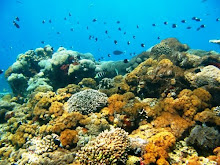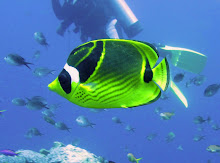Nusa Penida, off the island of Bali, is a particularly sensitive and beautiful area that is the natural environment for many diverse species of underwater life. Currently under the care of a Marine Protection Initiative headed by the Nature Conservancy Organisation, Nusa Penida is heralding a new generation of home grown, eco aware personnel who recognise not only the sensitivity of the marine environment, but also their own vulnerability. Their livelihoods depend on creating sustainable working relationships with the dive companies, fishermen and seaweed farmers.
Although Indonesia only covers 1.3% of the world’s land surface it is home to over 17% of the world’s plant and animal species. Some of these are found nowhere else in the world and many of them live beneath the surface of the seas. The waters around Nusa Penida hosts a kaleidoscope of living treasures from the largest known group of sea grasses to the spectacular Manta Rays and Mola Mola’s that live in the deeper water of the trenches between Peninda and Ceningan. The Mola Mola, or Tropical Sun Fish, is the symbol of Nusa Penida, a deepwater fish that can grow to two metres long with a fin span of up to four metres. Its name in German means ‘swimming head’ and when you see one you’ll know just why. There are other species, the chevron barracuda included, in the waters as well as moray eels and titan triggerfish.
Nusa Penida is the largest of a group of three islands located off the East Coast of Bali. It lies behind the slightly more populated island of Nusa Lembongan which has already become a marine playground where off shore pontoons dot the bay and host water slides and a proliferation of inflatable craft to speed thrill seekers across the surface of the sea. Nusa Penida is less populated, less developed and the reason for this may lie in the island’s history. Nusa Penida is believed to be the home of a Demon king, Jero Gede Macaling. Apparently a master of black magic he is reputed to be responsible for a number of natural disasters in the region.
The diving however is both safe and sensational; the deserted and calm beaches border the reef and most places are suitable for divers of all abilities, there are a couple of sites that are best taken by advanced divers due to the currents that rush between Nusa Lembonggan and Nusa Ceningan, these are Jurassic Point and Ceningan Pass.
According to the representative from the Coral Triangle Centre, Marthen Welly, dive companies are becoming wiser about the way they teach divers to treat the underwater environment, cautioning them against touching the coral, not just for their own protection from the scorpion fish and sea snakes but to protect the fragile coral. Coral is vulnerable to many destructive elements, over 88% of the coral in the Indonesian region is considered ‘at risk’. These risks include over fishing, the use of dynamite and the effects of climate change that brings about mass coral bleaching. When you think about the dependency the world has on coral this puts each accidental footstep into a different perspective. Globally over one billion people benefit from coral reefs, from the fish that depend on them for feeding and the related service industries associated with fish farming and tourism.
The work of the Bali based Coral Triangle Centre intends to establish marine protected areas that are designed to survive the challenges of human exploitation and disturbance as well as shifts in the climate. They also aim to provide benefit to the local fishing industry and nature based tourism, while protecting the biodiversity of the Nusa Penida area.
The Nature Conservancy works Indonesia wide. The Coral Triangle Centre (CTC) was established in 2000 with a mission to create a network of Marine Protection Areas. These areas are described by the CTC as ‘connected like a string of pearls across the Coral Triangle’. They work towards sustainable on-site preservation, with training in scientific and communicative skills, building a skilled workforce of managers and technicians to continue the work and pass it from generation to generation.
Another aspect of the Coral Triangle’s work is informing the general public of their projects, indeed it was a presentation by Marthen Welly to school students that brought the CTC to the attention of Villa and Yacht Magazine. With so much ‘bad’ news emerging from the environment movement it is delightful to see that here in Indonesia and Bali in particular that so many positive steps and meaningful actions are being taken to protect, preserve and promote the ongoing dynamic balance between man and the natural world.
For more information visit:http://www.coraltrianglecenter.org/ and http://www.nature.org/
source : http://www.villayacht.biz/index.php?option=com_content&task=view&id=156&Itemid=16
Senin, 07 Juli 2008
Langganan:
Komentar (Atom)










